When I first laid hands on a bass guitar in ’94, my engineering instincts piqued at the sight of an unsung hero – the humble bass bridge. Little did I realize how this encounter would open doors to a whole new world of sonic possibilities and design intricacies. Believe it or not, the character of every musical note you play is significantly influenced by this critical component.
Quite the claim, right? Well, I’m here to tell you exactly why that’s true. Over my decades-long journey, I have come to understand how differing types, features, or even the need for a bass guitar bridge replacement can drastically alter the performance and sound of your beloved instrument.
This comprehensive guide is my attempt to share this valuable knowledge. But remember, always let the essence of the music guide your hand, whether you’re choosing an adjustable bass bridge or comparing a 4-string versus a 5-string. Ready to dive in?
Types of Bass Guitar Bridges
4-string vs 5-string Bass Bridges
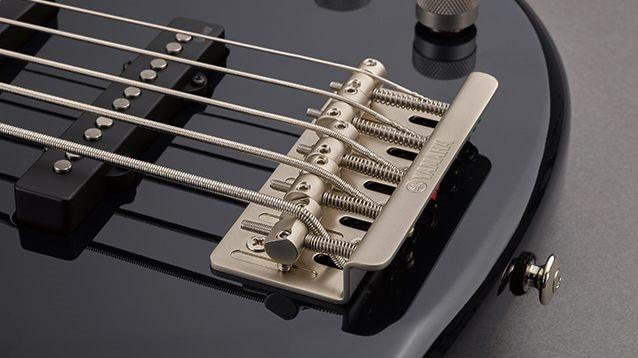
As we delve deeper into the landscape of bass guitar bridges, it’s impossible not to contrast the offerings of 4-string and 5-string bass bridges, intricacies that I’ve explored in my own crafting process. Both counterparts are substantially grounded in their relevance to the bass playing community, warranting a closer look at what sets them apart.
At the core of a 4-string bass bridge lies its tone. Predominantly, it offers a classic sound profile that is largely treasured in the music industry. The tonal range of a 4-string bass bridge symbolizes a simpler array of notes, focusing on the fundamentals of bass playing. This makes it an ideal starting point for amateur bassists who are exploring the world of bass tones.
On the flip side, a 5-string bass bridge infuses a distinctive depth to the low-end spectrum. The extra string gives a spacious range that extends the tonal reach on the lower end, enabling the delivery of powerful lows. This additional sonic capability caters to a wider range of musical genres and playing styles. Musicians well-versed in extended range bass playing often find the 5-string bass bridge an essential tool to their repertoire.
In my own crafting process, the distinction between a 4-string and a 5-string bass bridge is more than just about the number of strings. Each offers its own unique tonal palette, painting different musical landscapes. The 4-string bridge is a nod to tradition, delivering a clean and distinct bass tone. The 5-string bridge, however, unlocks a greater tonal diversity, allowing musicians to venture into uncharted territories of bass sounds.
Yet, the choice between these variants doesn’t merely revolve around their tonal traits. Practical factors like string spacing, bridge design, and material also come into play, influencing not just the sound, but also playability and comfort.
Ultimately, determining the ideal bass bridge – be it a 4-string or a 5-string – comes down to your sonic preferences, playing style, and comfort. Exploring more intricate types of bridges such as adjustable, high-mass, and vintage configurations – which we’ll delve into next – also forms part of this sound-seeking journey.
Adjustable vs High-Mass vs Vintage Bass Bridges
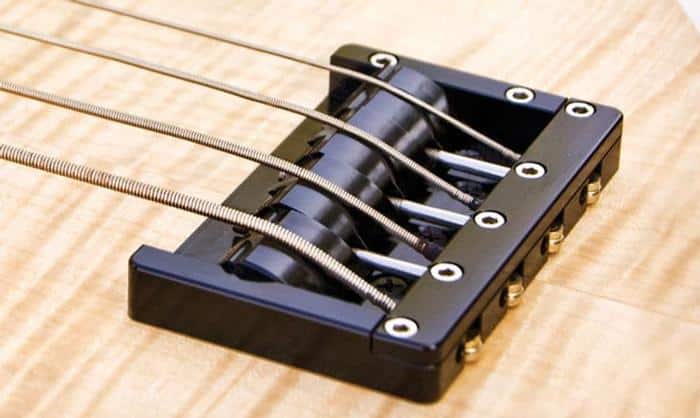
As a lifelong bass player and self-proclaimed gearhead, I’ve spent countless hours tinkering with different types of bass bridges. I’ve played on vintage bridges, highly-engineered high-mass bridges, and the dynamically flexible adjustable bass bridges. Each of these designs presents a distinct perspective on what a bass bridge should accomplish, influencing not just the instrument’s sound but its feel and handling too. Let’s delve into the nuanced comparisons between these bridge designs and their unique benefits.
Starting with the adjustable bass bridge, it’s all about versatility. With individual saddles for each string, the bridge allows you to adjust string height and intonation independently. This level of control is invaluable for establishing perfect playability and note clarity, making the adjustable bass bridge a versatile choice for those regularly dealing with different playing styles, tunings, or string gauges.
On the other hand, the high-mass bass bridge is gaining massive popularity for its depth and projection. These bridges often feature beefier designs, substantially adding to the physical weight of the bass. The increased mass translates into a profound resonance that is harmonically rich and maintains sustain for longer. My personal experience with these bridges always leaves me in awe of their musical impact; they allow for a noticeably fuller and robust sound. However, one downside is that these bridges may not have as much adjustability as their adjustable counterparts. Typically, the trade-off is worth it for those in search of a true sonic boom.
Moving on to the classic vintage bass bridge, they’ve held their ground in the ever-evolving world of bass guitar gear for good reason. Vintage designs often consist of a simplistic, tried-and-true setup that repeats certain proven aesthetics. These bridges may lack the adjustability of a modern bridge, but they offer a warm, familiar tone and feel known and loved by many bassists. Without getting too sentimental, there’s an undeniable charm to these bridges that’s often coupled with a well-rounded, punchy tone. Note, though, that vintage bridges can sometimes lack the sustain offered by high-mass bridges, and the intonation can be more challenging to set accurately.
In my journey through these different bridge designs, I’ve come to appreciate the unique contributions each one brings to the table. It’s crucial to understand that your choice greatly depends on your playing style, tonal preferences, and practical requirements. If you’re one for diversity and adaptability, go for the adjustable bass bridge. Are you chasing a heavy, booming sound with maximum sustain? The high-mass bass bridge is your best friend. Or perhaps, you’re a traditionalist at heart, and the vintage bridge’s familiar punchy tone rings truest for you. Regardless of the choice, let your bridge be a testament to your playing character and sound philosophy, allowing you to express your music with authenticity.
As we progress through this guide, I’ll share some of my favorite adjustable, high-mass, and vintage bridges in the market today and their standout features. By the time we’re done, you’ll be better equipped to make an informed decision about your next bass bridge.
Top Bass Guitar Bridges In The Market
Review: Leo Quan Badass

Fresh off our exploration of the leading bass guitar bridges in the market, there’s an icon that warrants more than just a casual mention – the Leo Quan Badass. This isn’t just a detour into nostalgia; this iconic bridge has influenced my playing for years.
Leo Quan Badass has been a cherished constant in my long span of bass playing. It’s distinct touch is etched in my fingers and the memory of its unique resonance isn’t easily forgotten. The Badass stands out in my personal ‘bass bridge reviews’ anthology for its unparalleled sustain and sonorous tonal quality.
The Badass provides an unprecedented level of sustain that set new standards in the industry. My strums rang longer, felt mellower, adding a depth to my music. Its well-engineered design also allowed me to push my creativity through its superior tonal control.
Having personally experienced the Badass bridge, I can confidently say that its versatile capabilities and enduring popularity remain unmatched. As we proceed to examine other significant bridges like the Babicz Full Contact and the Hipshot Bridge, you’ll notice why I held the Badass in such high esteem.
Review: Babicz Full Contact
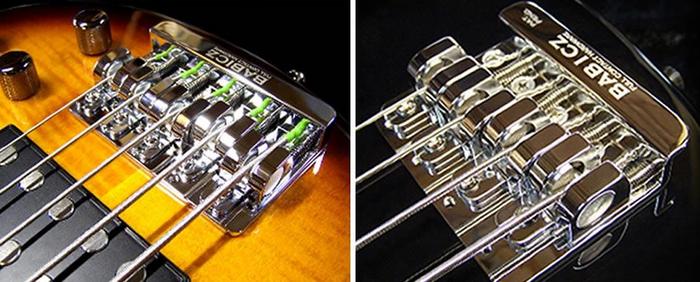
In my journey with bass guitar experimentation, the Babicz Full Contact has truly emerged as a game-changer. It stands out noticeably in the category of ‘Top Bass Guitar Bridges In The Market’. Every bass guitar lover would agree with me once they experience the difference this bridge makes.
The Babicz Full Contact brings a revolutionary design to the table, increasing the stability, sustain, and overall tone of your instrument. It’s all in the name – ‘Full Contact’ pertains to the more significant surface connection it allows between the vibrating string and the body of the bass. This results in unimpeded string energy transfer, enhancing the instrument’s tonal characteristics.
Poring over countless bass bridge reviews, I’ve observed recurrent praises for this model’s ability to deliver enhanced sustain and resonance. I concur wholeheartedly; across my own instruments fitted with the Babicz Full Contact, I’ve noticed a remarkable improvement in tonality and sustain. This says volumes about its contribution to the bass bridge market.
Transforming your bass’s tonal possibilities, without modifying any original elements in the process, the Babicz Full Contact is indeed a must-try. As we traverse other exceptional models, let the ingenuity of Babicz Full Contact resonate with you.
Review: Hipshot Bridge
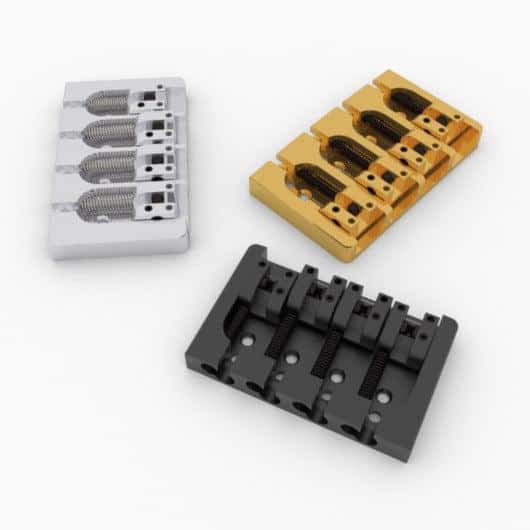
Our journey through the top bass guitar bridges in the market won’t be complete without a mention of the Hipshot bridge. The impact of this bridge on any bass guitar’s sound and performance is singular. It came on my radar after numerous ‘bass bridge reviews’ emphasized its precision and flexibility.
The first time I used the Hipshot bridge, it completely resonated with me. Here’s the kicker – the Hipshot bridge comes with impeccable tuning stability, making it an excellent choice for both novices and touring professionals. It gives your performance a unique ‘edge’ with its incredibly flexible string spacing, making it a standout contender in this category.
The Hipshot bridge also offers enticing specifications in terms of materials and design, ensuring durability and long-lasting performance. Essentially, it’s a work of art that breathes life into your bass guitar, serving as a passport to eclectic and mesmerizing tonal dynamic.
On wrapping up this review, it’s clear the Hipshot bridge is a significant contributor to our exploration of top bass guitar bridges, bringing an artful fusion of precision, flexibility, and durability. Next, we’ll delve into the iconic Fender bass bridge and what sets it apart in this distinctive landscape.
Review: Fender Bass Bridge
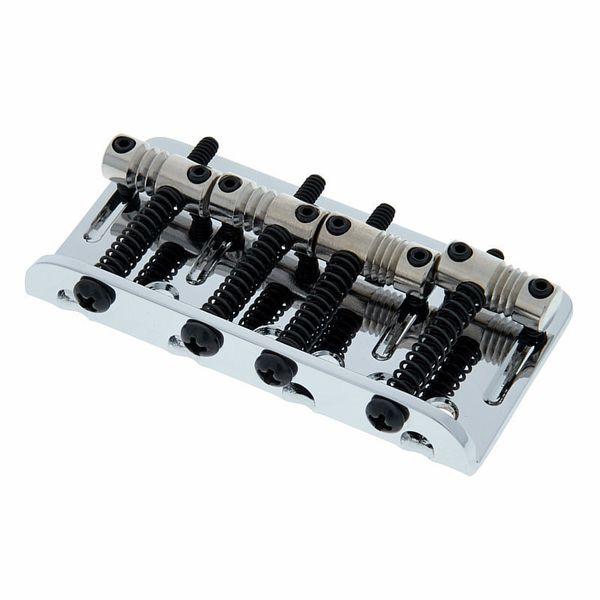
As part of the ‘Top Bass Guitar Bridges In The Market’ classification, the Fender bass bridge stands out for its iconic sound and design. My hands-on experience with this bridge across several of my bass builds has cemented its reputation as one of the best in its class.
Fender bass bridges embody a perfect blend of tradition and innovation. They offer a robust and rich tone that thrives in various musical styles. The vintage design, coupled with modern enhancements, provides the ultimate balance of aesthetics and functionality. This bridge is easy to install, and it imparts an immediate positive impact on the overall playability and resonance of the bass.
In bass bridge reviews, Fender’s remarkable quality is consistently highlighted. While exploring bass bridges, it’s challenging to find a product that matches the tonal clarity, longevity, and versatility that a Fender bridge provides. This has been my experience and it is widely mirrored in the bassist community.
Moving forward from this review, we’ll delve into a comprehensive comparison of the best bass bridges. I’m confident that the Fender bass bridge will hold its own, continuing to establish itself as a top-tier choice for any discerning bassist.
Best Bass Bridge: A Comparison
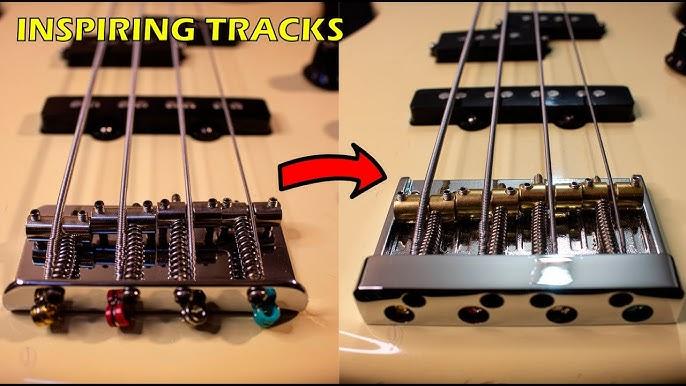
Alright, now that we’ve reviewed some of the top contenders, let’s dig deeper into the best bass guitar bridges. Drawing from my many years of practice and on-stage experiences, I will make a robust bass bridge comparison to guide your choice effectively.
Consider the Leo Quan Badass for its reliable stability and heavy mass – perfect for enhancing sustain. However, if you prioritize easy string action adjustment, the Babicz Full Contact may be preferable. It also offers a unique eCAM saddle system for a more profound tonal impact. With its brass shafts for additional strength, the Hipshot Bridge is remarkable for lower action and slapping style.
However, the Fender Bass Bridge, often seen as the industry standard, offers wider intonation adjustment range and a classic appeal. But, let’s not overlook individual preference and the nature of music you create – your ‘best’ may vary.
Bass bridge comparison is not merely about picking a ‘best’; it centers around understanding your needs and preferences. Remember, the ideal bridge promises more than just sound perfection; it brings you comfort and complements your musical essence. As we move on to bridge installation and setup, remember to pay close attention to your user experience.
Bass Guitar Bridge Installation and Setup
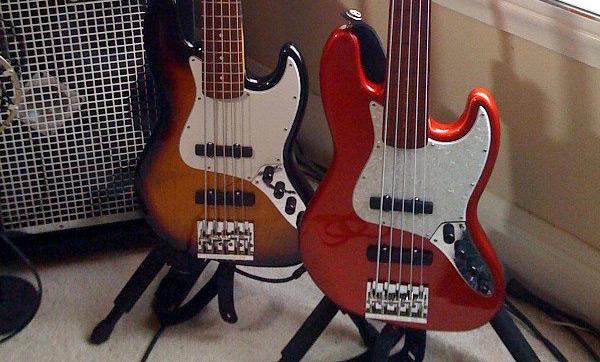
Having been deeply involved in countless bass bridge installations over the years, I’ve acquired a wealth of knowledge and insights into just how crucial a well-set-up bridge can be in defining the playability and tone of your bass. This critical, yet often overlooked, component can transform your playing experience and catapult your sound from good to amazing.
This brings us to a fascinating question: What if the secret to a great sounding bass lies as much in the setup as in the bridge itself?
Whether you’re installing a new bridge or tweaking your current setup, the process begins with a thorough understanding of the role and potential of the bridge. As a key transmitter of string vibration to the body, the bridge plays a pivotal role in shaping your bass’s tonal character. Balancing functionality with innovation, bass bridge setup has pivotal influence in spectral content, sustain, and dynamic response of your instrument.
I remember working on a client’s vintage Jazz Bass several years ago. The bass had a beautiful tone but lacked sustain and precision. The culprit, we discovered, was a poorly set-up OEM bridge. Post-adjustment and setup, the bass had a drastically different sound profile. The tonal difference was jaw-dropping, specifically due to the new bridge’s better design and setup.
A bass bridge installation necessitates a careful approach. You don’t simply replace the bridge; you align it meticulously with the neck to ensure optimal string action and intonation. This alignment, I’ve found, is what separates a decent setup from a professional one – it not only improves your bass’s playability but also brings out the unique tonal qualities of your instrument. Correct bridge placement and the resulting string action impact how the strings vibrate, how they transfer energy to the body, and ultimately, how your bass sounds.
Bass bridge setup is indeed an art in itself. Knowing how to manipulate this humble component can shape the playability and voice of your bass in unexpected ways, revealing dimensions of range and resonance that you wouldn’t believe possible.
I recall experimenting with high-mass bridges on a few basses in my collection. I noted increased sustain and overall sound density. These seemingly minute modifications in setup led to considerable improvements in sound, confirming my belief that a properly set-up bridge is just as influential in crafting your sound as the bridge itself.
While I’ve shared some of my experiences and learnings, we’ve only scratched the surface of this fascinating topic. Whether you’re considering an upgrade or just fine-tuning your existing setup, possessing a deep understanding of the bridge’s role, its installation intricacies, and the nuanced art of bass bridge setup will undoubtedly alter your perception of your instrument’s potential and vastly improve your playing. After all, the journey to the perfect bass tone is often a winding road of tweaks and adjustments.
Now, armed with your newfound appreciation for this small but mighty component, dive into the following sections as we delve deeper into improving your bass tone and sustain. The bridge and its setup might just become your secret weapon in refining your sound.
As we explore other bass bridge topics in subsequent chapters, remember these insights from my personal journey. Use them as guideposts to navigate your bass bridge exploration, and enjoy the fulfilling journey towards achieving your personal, perfect bass tone.
Improving Your Bass Tone and Sustain

I’ve been designing and working on bass guitar bridges for years, and the one thing I have come to realize deeply is that these small metal components have a huge influence on the overall playability and sound of my bass. The bridge can greatly affect your bass’s intonation, the tone, and the sustain.
Now, let’s talk about sustain. Sustain: is it the mystical ingredient in achieving the perfect bass tone you’ve been searching for? Potentially, yes and it’s not as complicated as the term might sound. In layman’s terms it refers to how long your notes last. Tuning your bass guitar bridge properly can noticeably improve both tone and sustain, an element that I have personally experienced throughout my dedicated years of refining my own designs.
The synchronization between the strings’ vibration and the wood of the bass creates a synergy that is reflected in the sustain. The longer the strings vibrate, the longer the notes sustain. And this sustain, in turn, is directly linked to the tone of the bass. An optimized sustain can enrich the depth and warmth of your bass tone, making each note fuller and more resonant.
Every detail, from the material of the bridge to its construction and alignment can make a significant difference. When I first started experimenting, I learnt that increasing the mass of the bridge results in better sustain. While a lightweight bridge may offer more comfort and easier playability, a high-mass bridge provides a better sustain and more powerful tone.
Intonation, the tuning accuracy of your bass along with its entire fretboard, is also a critical factor in achieving your bass tone and sustain. If not properly adjusted, your strings may not line up correctly with the frets, and the notes won’t sustain as they should. A well-adjusted bridge ensures true and consistent intonation all over the fretboard.
With every design and build, I’ve come to appreciate the craftsmanship that goes into perfectly balancing the factors of intonation, sustain, and tone improvement. Regardless of the type of bass guitar bridge – be it 4-string or 5-string, adjustable or high mass – taking the time to understand how its setup affects your playing will undoubtedly improve your overall performance.
Whether you are opting for a vintage bass bridge or a contemporary design model like Leo Quan Badass or Babicz Full Contact, make the choice that serves your style and playability preferences best. Experiment, tweak, adjust, and listen. The perfect bass tone and sustain are within your reach, ready to be fine-tuned and harnessed. Next time you pick up your bass, remember the bridge is not just a simple piece of hardware, but rather the soul of your instrument that can elevate your musical journey.
FAQs
What is a Bass Guitar Bridge?
The bridge of a bass guitar is a critical component that stabilizes the strings at their lower end. It supports the strings, provides a path for transmitting string vibration to the body, and allows adjustment of string alignment, length, and height.
What are the different types of Bass Guitar Bridges?
There are several types of bass guitar bridges including the vintage-style bridge, the high-mass bridge, and the through-body bridge. The vintage-style bridge is lightweight and provides a warm, vintage tone. The high-mass bridge is larger and heavier, providing more sustain and a crisper tone. The through-body bridge, where the strings feed through the guitar body, offers a unique tone and more string tension.
What features should I consider when choosing a Bass Guitar Bridge?
The main features to consider when choosing a bass guitar bridge include the type of bridge, the material it’s made from, its weight, and the amount of string spacing it provides. The bridge’s configuration for adjusting string height, intonation, and string spacing is also important for playability and sound customization.
How do I select the right Bass Guitar Bridge for me?
Choosing the right bass guitar bridge depends largely on your personal tone preference, playing style, and the type of bass guitar you have. You should consider the type of sound you want to achieve, the feel you prefer when playing, the guitar’s compatibility with different bridges, and your budget. It’s a good idea to try out different bridges if possible to find what suits you best.
Conclusion
Understanding the bridge of your bass guitar can take you on a remarkable sonic voyage. Reflecting on my research and teachings, a depth of appreciation for these essential bass guitar parts, incorporating the precision bass bridge and the jazz bass bridge, is a key to enriched technique and heart-stopping sound.
Is understanding your bass guitar’s bridge the key to a whole new world of enriched sounds and techniques? I believe it is. The articles on 4-string vs 5-string, adjustable vs high-mass vs vintage, and various top bass guitar bridges in the market, from Leo Quan Badass to the Fender Bass Bridge, should have instilled a deep understanding.
I sincerely hope this comprehensive study has illuminated the integral role your bass bridge plays. From installation to setup, to how it influences your tone and sustain, it’s a component that no bassist should underestimate.
Your newfound knowledge will guide you in your choice and manipulation of this crucial hardware, forging your unique sound. In this respect, the bridge serves as more than a functional part; it becomes an enabler of self-expression and artistry. Let’s cherish this understanding and let it resonate through every note we play.
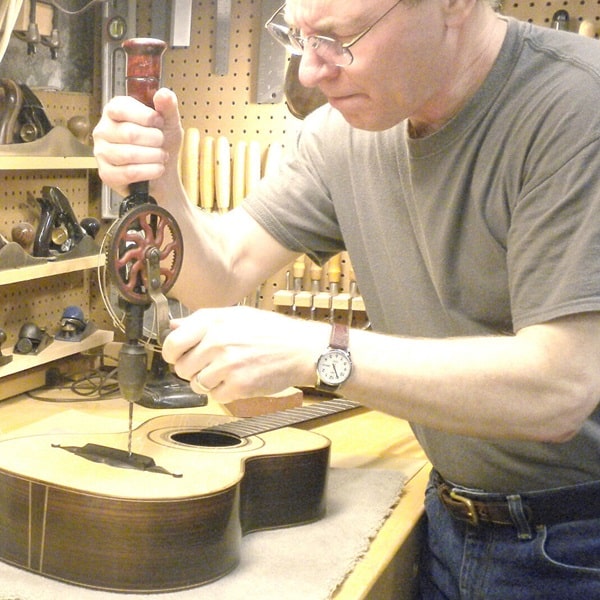
R.M. Mottola, an engineer-turned-luthier, revolutionizes stringed instrument design with his deep focus on acoustics and ergonomics since 1994. As editor of the Savart Journal and a key contributor to American Lutherie, Mottola merges science with artistry in lutherie. He enriches the field with his extensive knowledge, shared through his Liutaio Mottola website, making him a beacon in the world of modern instrument craftsmanship.
